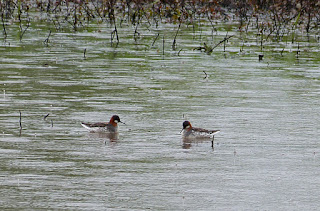I subscribe to the 4 F's of bird
photography; Find 'em and Focus
Fast before they Fly away!
Tuesday, May 07, 2013
Rare Bird Part II
Ah! The sun has reappeared after what feels like a whole week of rain, and it feels wonderful. Since we saw the rare Red Necked Phalarope during a downpour on Saturday, I thought I'd try again in the sun. Some people reported finding it, and others on the KY Birdlist said it was gone.
On Saturday, we saw two females at this vernal pond. Just to show you how small a bird this is, here is an un-zoomed view, as it were. That dark dot in the middle of the pond is the single Phalarope found today. No idea what happened to the other one - hope she's OK.
This gorgeous little girl was busy with her toilette today. Ducking into the water for a bath...
...stretching her wings up to help dry them, then preening each feather so it lays perfectly.
All this activity gave me some great looks at the markings on her wings...
...before a couple of dogs jumped into the pond. She took off in a hurry, but casually circled around, and when the dogs moved on, she landed in exactly the same spot to finish her bath before looking for a late afternoon snack.
The rest of the pond was empty except for one Teal-winged Duck couple, and this Green Heron, who also fled squawking to a nearby tree as the dogs came to his end of the pond. I always wish I could get a clear photo of the Meadowlarks who live on the other side of the pond, but guess I'll just be happy listening to their beautiful songs!
Saturday, May 04, 2013
Rare Bird in Kentucky
The sun may shine bright on my old Kentucky Home, but not today. Even though it's Derby Day here in Louisville, the rain will probably be falling most of the day. What does the fashionable birder wear on such a day? A green rain poncho, of course! Unfortunately, cloudy skies and rain are not the best conditions for photographing a rare bird sighting of these Red Necked Phalarope found on a small pond in a city park nearby, so please forgive the fuzziness of these photos.
Dick remarked that they looked much larger in the field guide, and it was hard to find them at all in the camera lens since they are only about 7" long, with lobed toes and a straight, fine bill. Red-necked Phalaropes, like Red Phalaropes but unlike other shorebirds, prefer to swim rather than wade, a habit that enables them to spend the winter on the high seas, although on occasion they wade in pools and feed on mudflats with many other shorebirds.
When feeding, a Red-necked Phalarope will often swim in a small, rapid circle, forming a small whirlpool. This behavior is thought to aid feeding by raising food from the bottom of shallow water. The bird will reach into the center of the vortex with its bill, plucking small insects or crustaceans caught up therein. On the open ocean, they are often found where converging currents produce upwellings. During migration, some flocks stop over on the open waters at the mouth of the Bay of Fundy to take advantage of food stirred up by tidal action.
How rare are they? Looking at the map, you can see that they breed along the Artic Circle, and winter far to the south. Almost all of the nonbreeding season is spent in open water. As this species rarely comes into contact with humans, it can be unusually tame. Ours weren't concerned at all when some folks with dogs walked by. Easy to see, mid-May-Jul, in the Arctic; otherwise seen on pelagic boat trips during migration or from coasts during on-shore gales in fall.
The typical avian sex roles are reversed in the three phalarope species. Females are larger and more brightly colored than males. These were pretty bright, so we think they are both females. The females pursue and fight over males, and will defend their mate from other females until the clutch is complete and the male begins incubation. The males perform all incubation and chick-rearing activities, while the females may attempt to find another mate. If a male loses his eggs to predation, he may re-pair with his original mate or a new female to try again. Once it becomes too late in the breeding season to start new nests, females begin their southward migration, leaving the males to incubate the eggs and look after the young.
This sure beats going to the track in the rain and having all your possessions search by security people. Did you know that you are NOT allowed to carry umbrellas to Churchill Downs?
Thursday, May 02, 2013
The Hills Are Alive with the Sound of Birdsong
 |
| Scarlet Tanager
|
In the last 24 hours, I have been inundated with beautiful bird songs! We decided to join the Beckham Bird Club's trip to Mammoth Cave, and it was truly worthwhile.
 |
| Summer Tanager |
 |
| Indigo Bunting |
 |
| Red-eyed Vireo |
 |
| Louisiana Water Thrush |
 |
| Common Yellowthroat |
 |
| Eastern Bluebird |
Oh, and thank you Blogger for updating your software. It's about time we can select multiple photos to upload at one time, and get little red squiggles for misspelled words. Hooray!
Subscribe to:
Posts (Atom)










